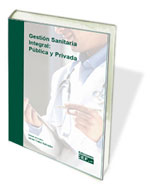ABELLÁN, J.M. y PINTO, J.L. «Quality Adjusted Life Years as expected utilities». Spanish Economic Review, 2(1); 2000. 49-63.
ALONSO, J. y colabs. Versión española de SF-36v2™ Health Survey © 1993, 2003.
ALONSO, M.C. (inv. principal). «Cribado familiar en el cáncer de mama: análisis de un registro hospitalario. Estudio de coste-efectividad». En Agencia de Evaluación de Tecnologías Sanitarias. Resultados de investigación sobre evaluación de tecnologías sanitarias: diagnóstico precoz y clínico en oncología. Informe de Evaluación de Tecnologías Sanitarias, n.º 32. 2002.
BADÍA, X. y LIZÁN. «Estudios de calidad de vida». En: Martín, A. y Cano, J.F.: Atención Primaria: conceptos, organización y práctica clínica. Volumen I. Madrid: Elsevier España. 2003. 250-61.
BADÍA, X., ROSE, M., MONTSERRA, S., HERDMAN, M. y SEGURA, A. «The Spanish version of EuroQol: a description and its applications. European Quality of Life scale». Medicina Clínica, 1999. 112 Suppl 1, 79-85.
BERGSON, A. «A reformulation of certain aspects of welfare economics». Quaterly Journal of Economics, 52(2), 1938. 310-334.
BRAZIER, J., DEVERILL, M., GREEN, C., HARPER, R. y BOOTH, A. «A review of the use of health status measures in economic evaluation». Health Technology Assessment, 3 (9). 1999.
BRIGGS, A.H. y O’BRIEN, B.J. «The death of cost-minimization analysis?» Health Economics, 10, 2001. 179-184.
BROCK, D.W. «Ethical Issues in the Development of Summary Measures of Population Health Status». En: Gold M.J., Gold M.R. (eds.). Summarizing Population Health: Directions for the Development and Application of Population Metrics.Washington, DC: National Academy Press, 1998 73–85.
CAIRNS, J.A. y van der POL, M.M. «Saving future lives. A comparison of three discounting models». Health Economics, 6, 1997. 341-350.
CONTEH, L. y WALKER, D. «Cost an unit cost calculations using step-down accounting». Health Policy and Planning, 19(2), 2004. 127-135.
CULYER, A.J. «Commodities, characteristics of commodities, characteristics of people, utilities and quality of life». In: Baldwin, S., Godfrey, C. y Propper, C., editors. The quality of life: perspectives and policies. London: Routledge. 1989.
DRUMMOND, M.F. «Experimental versus Observational Data in the Economic Evaluation of Pharmaceuticals». Medical Decision Making, 18(2), s12-s18. 1998.
DRUMMOND, M.F., SCHULPHER, M.J., TORRANCE, G.W., O’BRIEN, B.J. y STODDART, G.L.: Methods for the Economic Evaluation of Health Care Programmes.3rd ed. Oxford: Oxford University Press. 2005.
EICHLER, H.G., KONG, S.X., GERTH, W.C., MAVROS, P. y JONSSON, B.: «Use of cost-effectiveness analysis in health-care resource allocation decision-making: how are cost-effectiveness thresholds expected to emerge?» Value Health, 7(5), 2004. 518-28.
GARCÍA-GIRALDA, L. y colabs. «Calidad de Vida Relacionada con la Salud en pacientes con incontinencia urinaria en atención primaria». Boletín epidemiológico de Murcia, 25(653), 2004. 5-7.
GOLD, M.R., SIEGEL, J.E., RUSSELL, L.B. y WEINSTEIN, M.C. (eds): Cost-effectiveness in Health and Medicine, 1.st edn. New York: Oxford University Press. 1996.
GOODACRE, S. y CALVERT, N. «Cost effectiveness of diagnostic strategies for patients with acute, undifferentiated chest pain». Emergency Medical Journal, 20, 2003. 429-433.
GROSSMAN, M. «On the concept of human capital and the demand for health care». Journal of Political Economy, 80, 1972. 223-55.
HICK,S JR. «The foundations of welfare economics». Economic Journal, 49, 1939. 696-710.
HOLTGRAVE, D.R. y QUALLS, N.L. «Threshold Analysis and Programs for Prevention of HIV Infection».Medical Decision Making, 15, 1995. 311-317.
JOHNSTON, K., BUXTON, M.J., JONES, D.R. y FITZPATRICK, R. «Assessing the costs of healthcare technologies in clinical trials». Health Technology Assessment, 3 (6). 1999.
KALDOR, N. «Welfare propositions of economics and interpersonal comparisons of utility». Economic Journal, 49, 1939. 549-52.
KARNOFSKY, D.A. y BURCHENAL, J.H. «The clinical evaluation of chemoterapeutic agents against cancer». In: McLeod, C.M., editor. Evaluation of chemotherapeutic agents. New York: Columbia University Press. 1949.
KARTMAN, B., ANDERSSON, F. y JOHANESSON, M. Willingness to Pay for Reductions in Angina Pectoris Attacks. Medical Decision Making, 16, 1996. 246-263.
KEELER, E.B. y CRETIN, S. «Discounting of lifesaving and other nonmonetary effects». Management Science, 29, 1983. 300-6.
KLOSE, T. «A Utility Theoretic Model for QALYs and Willingness to Pay». Health Economics, 12, 2003. 17-31.
KOOPMANSCHAP, M.A., RUTTEN, FFH, van INEVELD, B.M. y van ROIJEN, L. «The friction cost method for measuring indirect costs of disease». Journal of Health Economics, 14(2), 1995. 171-89.
KRUPNICK, A.J. Valuing health outcomes: Policy Choices and Technical Issues. RFF Report. Washington D.C. 2004.
LANCASTER, K. «A new approach to consumer theory». Journal of Political Economy, 74(2), 1966. 132-57.
— Consumer Demand: A New Approach. Columbia University Press, New York. 1971.
LEUNG, P.P., TANNOCK, I.F., OZA, A.M., PUODZIUNAS, A. y DRANITSARIS, G. «Cost-Utility Analysis of Chemotherapy Using Paclitaxel, Docetaxel, or Vinorelbine for Patients With Anthracycline-Resistant Breast Cancer». Journal of Clinical Oncology, 17, 1999. 3.082-3.090.
MISHAN, E.J. «Evaluation of life and limb: a theoretical approach». Journal of Political Economy, 79, 1971. 687-705.
MITTENDORF, T., MERKESDAL, S., HUELSEMANN, J.L., von der SCHULENBURG, J.M., ZEIDLER, H. y RUOF, J. «Implementing standardized costs categories within economic evaluations in musculoeskeletal diseases», European Journal of Health Economics, 4 (1), 2003. 43-49.
NEUHAUSER, D. y LEWICKI, A.M.: «What Do We Gain from the Sixth Stool Guaiac?». New England Journal of Medicine, 293(5), 1975. 226-228.
O`BRIEN, B., y GAFNI, A.: «When do the “dollars” make sense? Toward a conceptual framework for contingent valuation studies in health care». Medical Decision Making, 16(3), 1996. 288-99.
O’BRIEN, B.J., ANDERSON, D. y GOEREE, R.: «Cost-effectiveness of enoxaparin versus warfarin prophylaxis against deep vein thrombosis after total hip replacement». Canadian Medicine Association Journal, 150, 1994. 1.083-172.
OLIVA, J., SACRISTÁN, J.A., DEL LLANO, J.: «Evaluación económica de tecnologías sanitarias en España. Revisión de la década 1990-2000». Gaceta Sanitaria, Supl 2, 2002. 1-9.
PHELPS, C. y MUSHLIN, A.: «On the near equivalence of cost-effectiveness and cost-benefit analyses». International Journal of Technology Assessment of Health Care, 7, 1991. 12-21.
PINTO, J.L. y RODRÍGUEZ, R.: «¿Cuánto vale la pena gastarse para ganar un año de vida ajustado por calidad? Un estudio empírico». En Puig, J. y Pinto, J.L., Dalmau (dirs.): El valor monetario de la salud. Barcelona: Springer-Verlag, 2001.
PINTO, J.L. y SÁNCHEZ, F.I.: Métodos para la evaluación económica de nuevas prestaciones. Ministerio de Sanidad y Consumo: Madrid. 2003.
PINTO, J.L., VÁZQUEZ, M.X., LÁZARO, A. y MARTÍNEZ, J.E.: Análisis coste-beneficio en la salud. Barcelona: Masson. 2003.
PLISKIN, J.S., SHEPARD, D.S. y WEINSTEIN, M.C.: «Utility functions for life years and health status». Operations Research, 28(1), 1980. 206-54.
PUIG-JUNOY, J., ORTúN-RUBIO, V. y PINTO-PRADES, J.L. : «Los costes en la evaluación económica de tecnologías sanitarias». Atención Primaria, 27 (3), 2001. 186-189.
RITTENHOUSE, B.E. y O’BRIEN, B.J.: «Threats to the validity of pharmacoeconomic analyses based on clinical trial data». In Spilker, B (ed). Quality of Life and Pharmacoeconomics in Clinical Trials. 2nd ed. Philadelphia, PA: Lippincott-Raven. 1996.
RYAN, M. y FARRAR, S.: «Using conjoint analysis to elicit preferences for health care». British Medical a Journal, 320, 2000. 1.530-1.533.
SACRISTÁN, J.A., OLIVA, J., DEL LLANO. J,, PRIETO, L. y PINTO, J.L.: «¿Qué es una tecnología sanitaria eficiente en España?». Gaceta Sanitaria, 16(4), 2002. 334-43.
SAMUELSON, P.A.: Foundations of economic analysis. Harvard University Press: Cambridge. 1947.
SENDI, P., GAFNI, A. y BIRCH, S.: «Opportunity costs and uncertainty in the economic evaluation of health care interventions». Health Economics, 11, 2002. 23–31.
STIGGELBOUT, A.M.: «Assessing Patients’ Preferences». En Chapman, G.B. y Sonnenberg, F.A. (eds.). Decision Making in Health Care. Cambridge University Press. 2000.
STIGGELBOUT, A.M. y DE HAES, JCJM.: «Patient Preference for Cancer Therapy: An Overview of Measurement Approaches». Journal of Clinical Oncology, 19(1), 2001. 220-230.
STONE, P.W., CHAPMAN, R.H., SANDBERG, E.A., LILJAS, B. y NEUMAN, P.J. : «Measuring costs in cost-utility analyses. Variations in the literature». International Journal of Technology Assessment in Health Care 2000; 16(1), 2000. 111-24.
SUTHERLAND, H.J., LLEWELLYN-THOMAS, H., BOYD, N.F. y TILL, J.E.: «Attitudes towards quality of survival: The concept of maximum endurable time». Medical Decision Making, 2, 1982. 299-309.
SUTHERLAND, H.J. y TILL, J.E.: «Quality of life assessments and levels of decision making: differentiating objectives». Quality of Life Research, 2, 1993. 297-303.
TORRANCE, G.W., FEENY, D. y FURLONG, W.: «Visual Analog Scales: do they have a role in the measurement of preferences for health states?». Medical Decision Making 21(4), 2001. 329-334.
von NEUMANN, J. y MORGENSTERN, O.: Theory of games and economic behaviour. Princeton: Pricenton: The University Press.1944.
WAGSTAFF, A.: «QALYs and the equity-efficiency trade-off». Journal of Health Economics, 10, 1991. 21-41.
WANG, S.J. y colabs.: «A Cost-Benefit Analysis of Electronical Medical Records in Primary Care». American Journal of Medicine, 114, 2003. 397-403.
WEINSTEIN, M. y ZECKHAUSER, R.: «Critical ratios and efficient allocation». Journal of Public Economics, 2, 1973. 147-157.
WEINSTEIN, M., STASON, W.B.: «Foundations of cost-effectiveness analysis for health and medical practices». New England of Journal Medicine, 296, 1977. 716-21.
WEINSTEIN, M.C., SIEGEL, J.E., GOLD, M.R., KAMLET, M.S. y RUSSELL, L.B. : «Recommendations of the Panel on Cost-effectiveness in Health and Medicine». JAMA, 276, 1996. 1.253-8.
WILLIAMS, A.: «Intergenerational equity: an exploration of the ‘fair innings’ argument». Health Economics. 1997, 6(2), 117-32.
– «The fair innings argument deserves a fairer hearing». Health Economics 2001, 10, 583-585.



